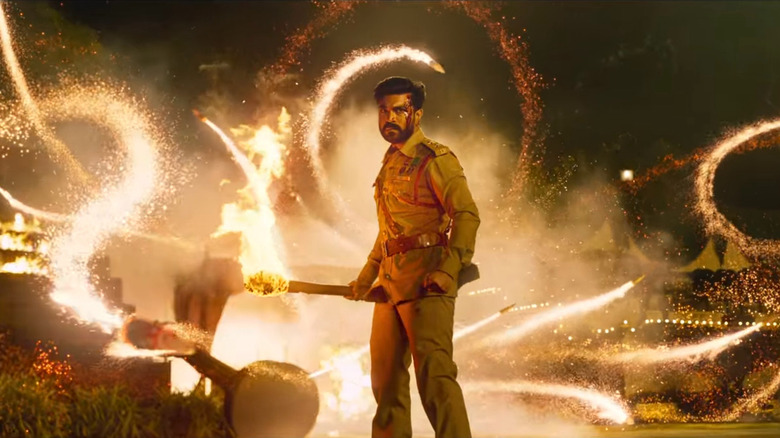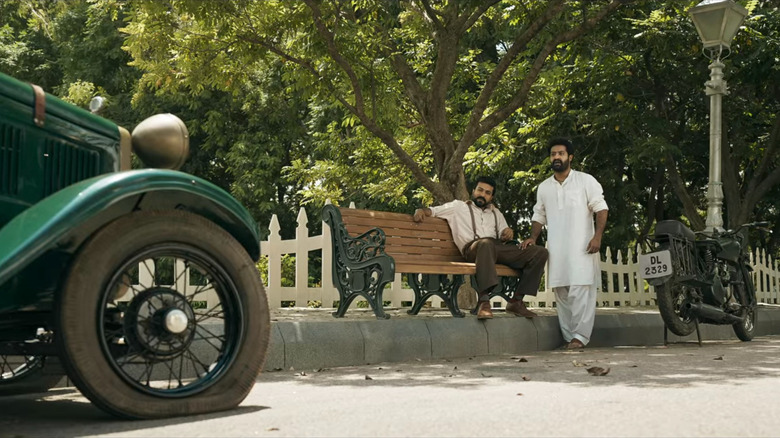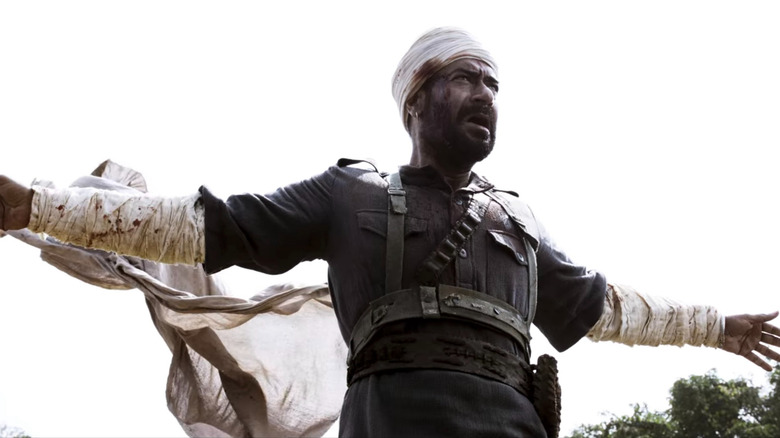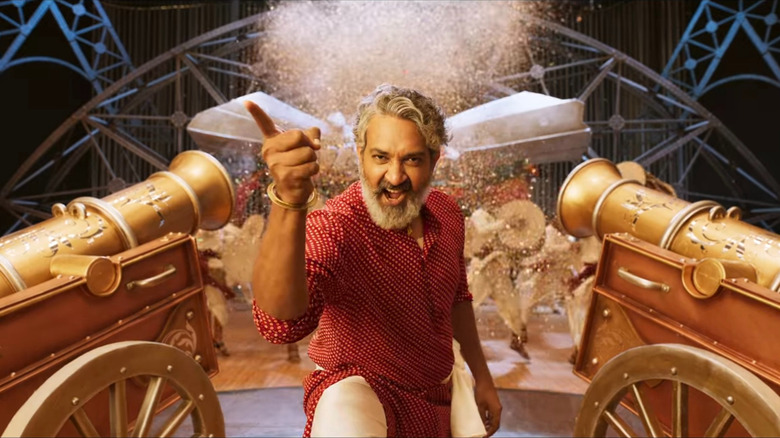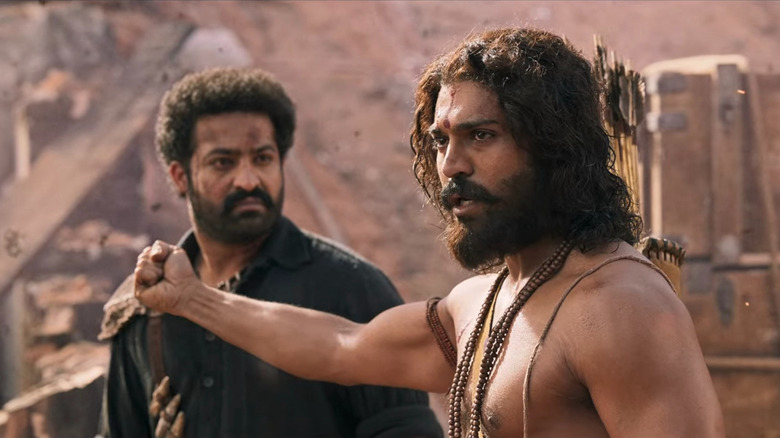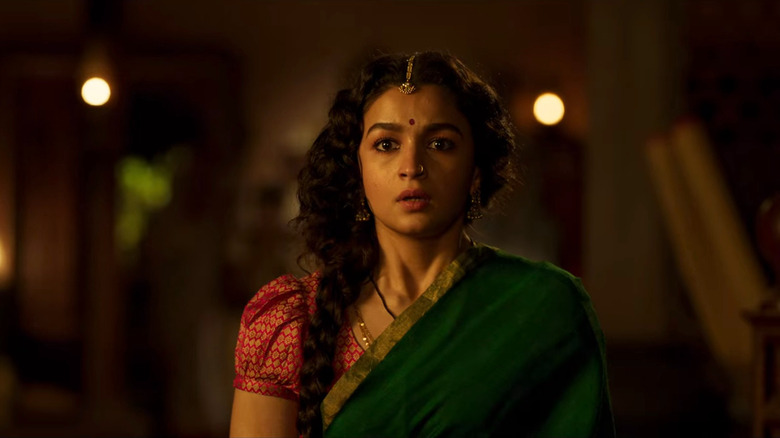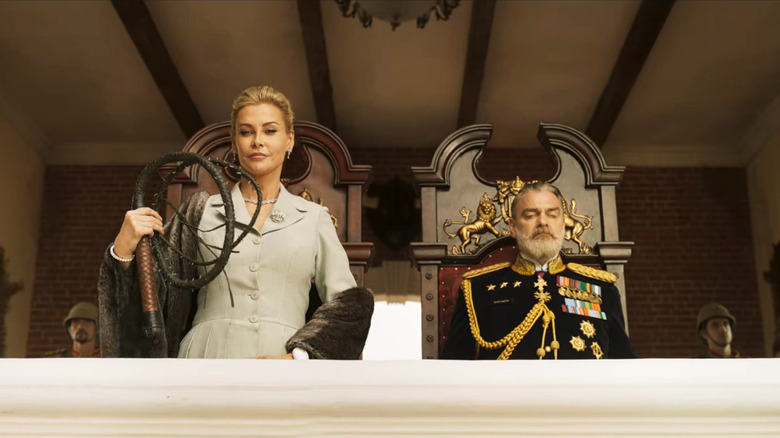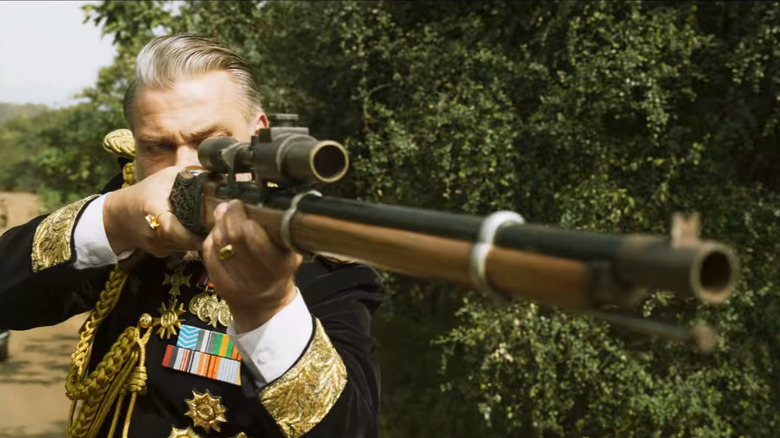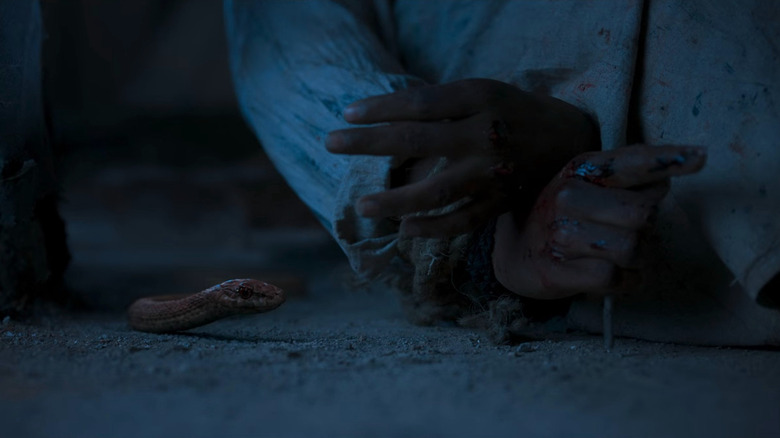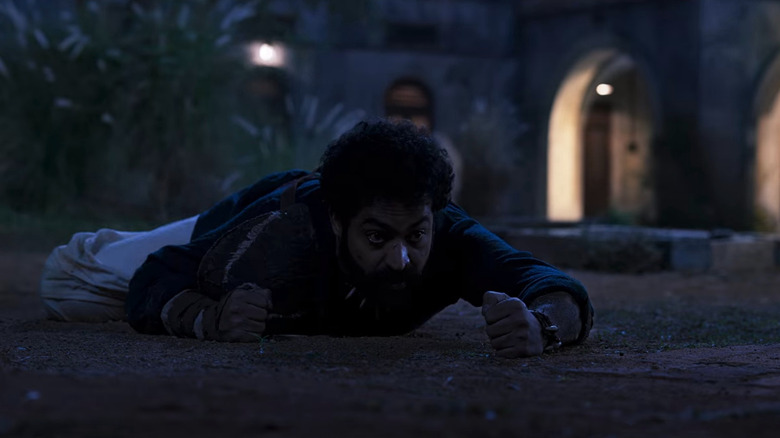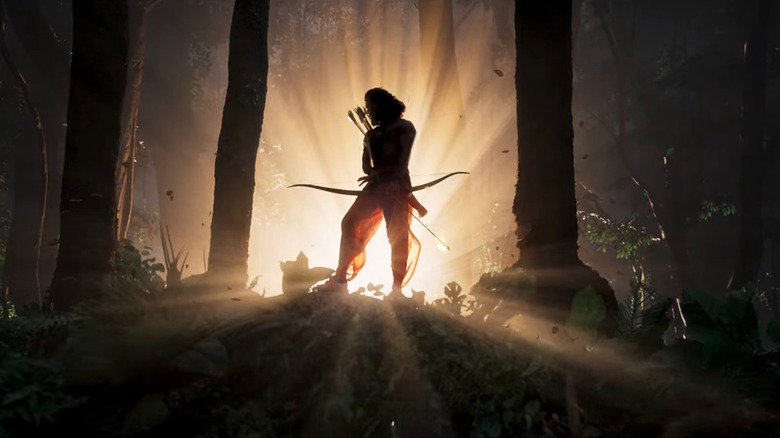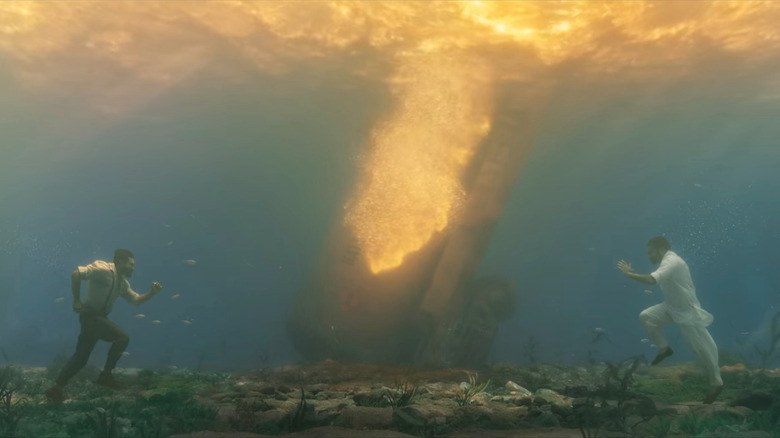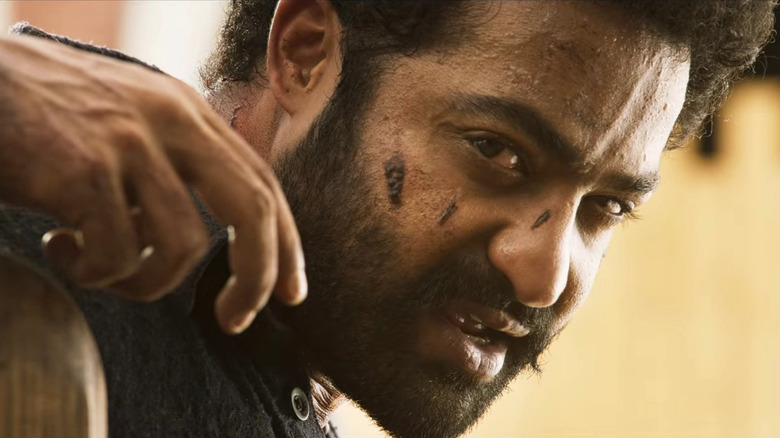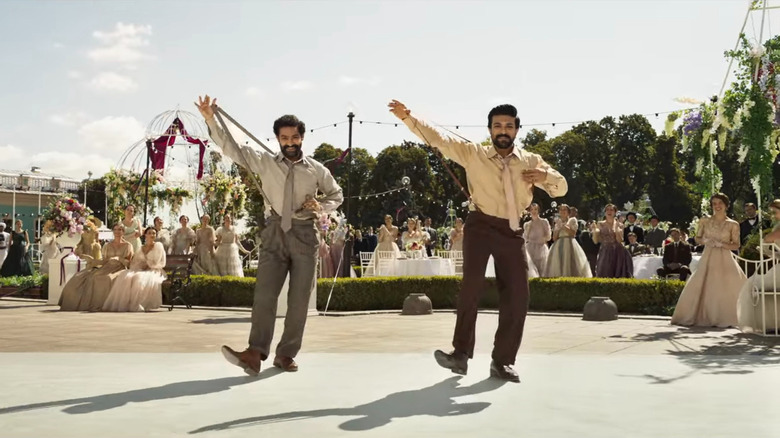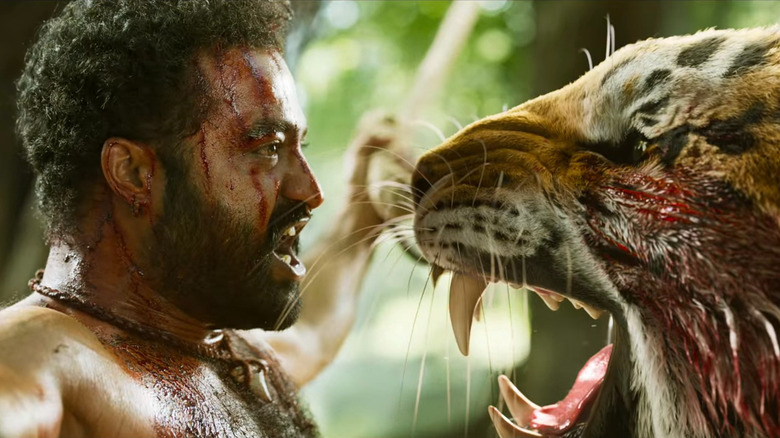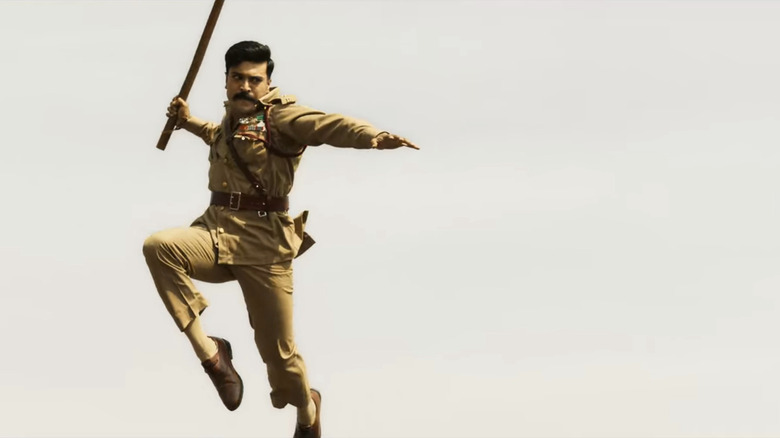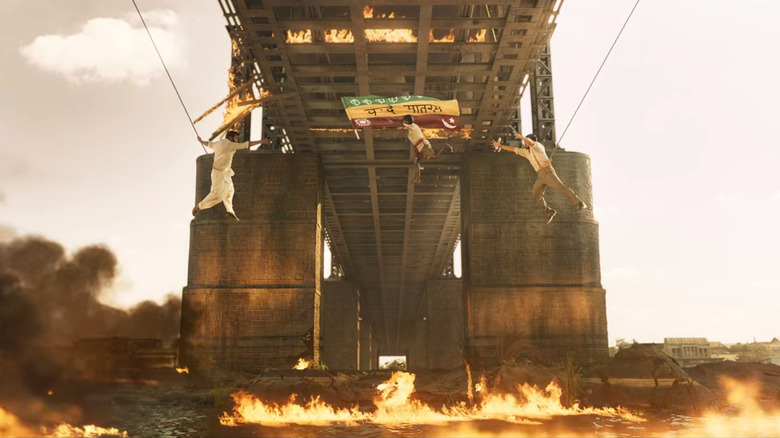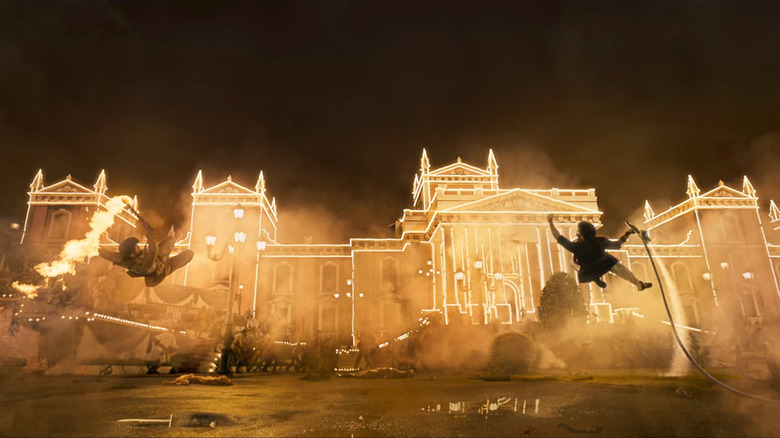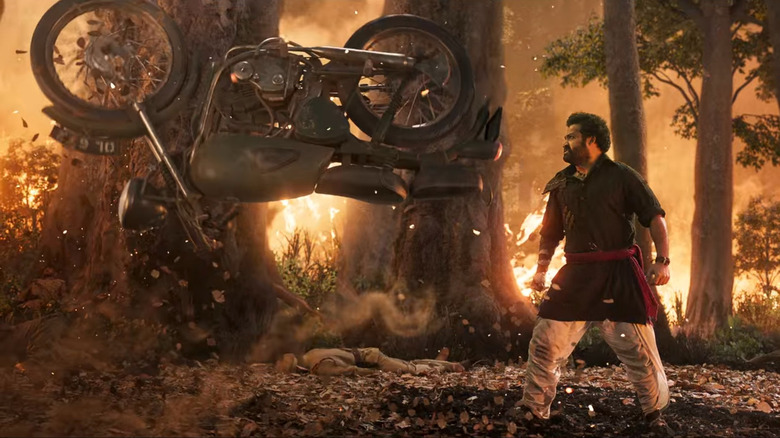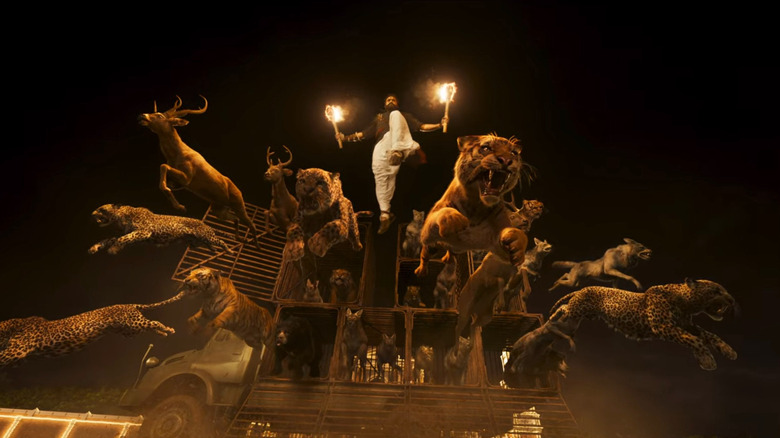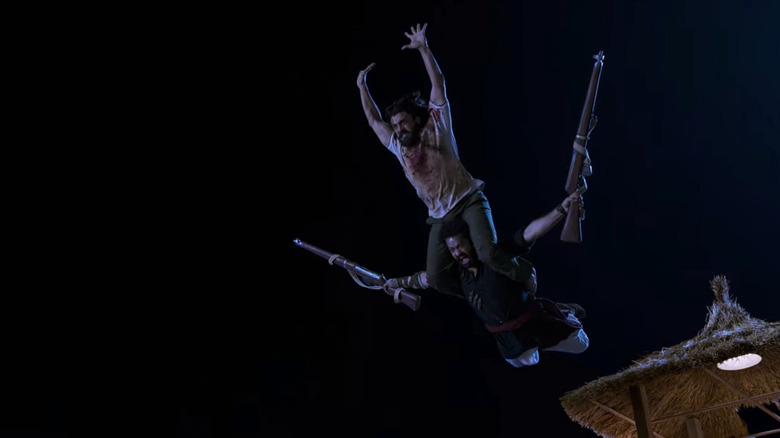The 20 Best Moments In RRR, Ranked By How Much We Can't Believe What We Saw
"RRR" is electrifying cinema. The film runs over three hours long and can barely contain the amount of extravagant, invigorating, and beautiful moments that make you remember why you love the medium of film in the first place. Director S.S. Rajamouli's ability to wow an audience within the context of a big-budget action film dwarfs just about everything being produced by the Hollywood machine. Even just the way he frames his two leading men, Ram Charan and N.T. Rama Rao Jr. (henceforth to be referred to as Jr NTR), gives them an iconographic status even the biggest movie stars are rarely afforded. So many images have been imprinted on my brain that I will never forget.
In celebration of this fantastic film that is doing so much to help expose so much of the world to the wonders of Indian, and especially Telugu-language, cinema, let's look at some of the best parts of "RRR." Instead of doing a boring ranking that counts down those moments by how great they are, let's take a bit of a swerve in how we look at them. "RRR" is filled with so many instances of the extreme, where what is happening on screen could never happen in real life. So, let's count down the film's best moments by how unbelievable they are, meaning that you literally cannot believe what is happening on the screen. Much of what happens in "RRR" would firmly classify as unbelievable and parsing the differences may be a little silly. But, hey ... "RRR" is a fun time, so why not have some fun when talking about it?
Oh, and there will be spoilers.
Raju helps Bheem meet the girl he likes
One of the most delightful moments of "RRR" is also one of its most believable. Ram Charan's Raju sees that Jr NTR's Bheem has a debilitating crush on Jenny (Olivia Morris), the kind British woman who lives in the Governor's estate. Bheem has absolutely no game, unwilling to even approach this woman. Raju, being the cool bro he is, decides to help his friend out. But this is "RRR." He cannot just tell Bheem to go up and talk to Jenny. Something elaborate has to happen. So, Raju grabs a handful of nails and screws and decides to flatten the tires of Jenny's car, which forces the two potential love birds to have a meet-cute.
In a movie filled with extremes, this is the smallest of its most major moments. The scene is designed for maximum charm, humor, and loveliness, and Jr NTR's comic chops of totally not understanding what Raju is doing at the moment really works. If a guy purposefully popped the tires of a woman's car in real life, it would be truly upsetting, but in the vibe of this movie, it's the only way this could have happened.
Load, aim, shoot
After the film's "InteRRRval," we are treated to a lengthy flashback about Raju's childhood. We learn about his father (Ajay Devgn) and how he abandoned the British forces and began a revolutionary army of his own. We learn how Raju was a natural with a rifle in his hands. Most importantly, we learn that he is not, in fact, working for the British out of loyalty but as a long con operation to provide anyone willing to fight back against the imperialists with a weapon, a lesson he learned from his father.
The moment that needs spotlighting acts as the emotional highpoint of the flashback sequence. Their camp has been sieged by British soldiers, Raju's brother and mother have been killed, and his father does not have much time left in this world. They devise a plan where Raju's father will appear to be giving himself up to the British forces, but in reality, he will be using himself as a bomb, wrapping himself in dynamite and having the young Raju shoot him to cause the explosion.
While it is an enormously extreme moment dramatically, in terms of believability, it makes all the sense in the world. Yes, it is a bit farfetched that a young boy could be such a crack shot with a rifle, but the revolutionary mindset here rings utterly true.
A last second cameo
S.S. Rajamouli had a cameo for himself in "Bāhubali: The Beginning," the first entry in his two-part epic, as a seller of spirits that Prabhas' titular character procures as an elaborate distraction. It would make sense for him to show up in his next film as well, but you get to the point where the credits are rolling without ever seeing him. And then, during the anthemic final musical number "Etthara Jenda," the silver-haired Rajamouli pops into frame as two confetti cannons blast behind him. He does not even cameo as a character. He is just himself showing up in the celebratory closing moments of his film.
Look, it's just an absolute boss move to do this. He made this gigantic film that was the most expensive production in Indian film history. Why should he not get to join in on the musical number to cap off his achievement?
Sending a bullet back to England
One of the most satisfying and rousing moments of "RRR" also happens to be one of its most predictable. The film has built to this epic battle between the Indian freedom fighters and the evil British colonialists, and the only proper satisfying conclusion to that struggle would be Bheem and Raju teaming up to put the nail in the coffin of the sneering Governor (Ray Stevenson). They do this by reciting back to him his belief that a bullet should not be wasted on the life of an Indian because they aren't worth it. Instead, a bullet must be reserved to take the life of an Englishman, which Bheem and Raju are more than happy to carry out.
The most unbelievable part of this moment is just that this same Englishman has been circling their lives so much that even Raju's long-dead father has heard this disgusting bullet speech. He is the figurehead for the entire British crown, when in reality there were a plethora of folks just like him. If he is the Governor, it does make sense that he would be in this area, but there is still quite a bit of coincidence that has to occur to bring them to this moment. However coincidental, it is still incredibly cathartic.
Sita protects (and then meets) Bheem
We have to chalk another piece of the film up to pure coincidence. After Bheem has rescued the little girl Malli (Twinkle Sharma) that has been his mission, the two have been maneuvering from town to town to avoid the British authorities. They find themselves in an inn in last town in the region to be checked. In that same inn, we see Sita (Alia Bhatt in her Telugu language debut), the woman set to marry Raju. When the inn gets raided by a group of soldiers, Sita recognizes that there are people in here who really do not want to be found, so she has the brilliant idea to say that there is a smallpox infestation among the people. This is before she has even spoken a word to Bheem and knows that he is Raju's best friend (despite some misunderstood betrayal).
It is an incredibly selfless act that Sita performs here, even getting kicked in the stomach by one of the officials. Seeing people do things just out of the good of their heart is a rarity, and in the world we live in today, it almost comes across as pure fantasy. Pair that with the fated meeting between the two loves of Raju's life, and you have something that is fairly unbelievable.
A surprise second whip
This moment makes me want to ask so many questions. For context, Bheem has been arrested by Raju and is now being publicly whipped. The goal of the Governor and his wife (Alison Doody) is to have Bheem fall to his knees in subjugation to the British crown. However, no matter how hard Raju whips Bheem, he will not kneel. Then ... Alison Doody pulls out this whip that is covered in spikes and throws it down to Raju.
I understand that there's another whip available to increase the pain of this torture. What I do not understand is why she has it. Does she just carry this whip around? Why isn't it already down on the block where the actual whipping is taking place? Her revealing this whip just exists to do two things: make the British look even more sadistic and amp up the stakes of the scene between these two men. On those two fronts, it completely works. The moment is completely convoluted, but in the heightened space that is "RRR," you just have to accept it.
The Governor wrecks Raju's car
What makes this moment stand out is not what happens but how it happens. On the drive to Bheem's hanging, the Governor discovers that Raju is planning to break Bheem out and escape. He has rigged a tree to fall down and crush the Governor's car, but the Governor notices this just in the nick of time. The tree falls onto the hood of the car, propelling him into the air. While in mid-air, the Governor grabs his rifle, aims, and shoots Raju's car. From just one shot, that car takes to the air, flipping several times over its side like it was on a ramp, and sends Raju and Malli flying, with Raju getting non-fatally impaled by a jutting tree stump.
While the car flipping could be the most exaggerated moment of the sequence, I want to focus on the Governor. Ray Stevenson's character essentially floats in the air for this moment to work as effectively as it does. All of the fanciful, slow-motion enhanced images of power have been exclusively reserved for Raju and Bheem. This is the one time the Governor gets in on the action, and it perfectly demonstrates what a formidable force he, and by proxy, the British imperialists, can be. With one blow, he can destroy everything they have worked for. The whipping scene is obviously more emotionally wrenching, but this moment is the one where you almost feel the most helpless, which is a wonderful dramatic choice by Rajamouli.
Lachu snatches a lunging snake
I don't know about you, but I don't like snakes. As far as I can get away from them, the better. I certainly would not be trying to lure an incredibly deadly snake towards me with a stick hoping to catch it with my hands tied around my back. Well, that is exactly what Bheem's compatriot Lachu (Rahul Ramakrishna) does in order to poison Raju, who is violently interrogating him about Bheem's whereabouts. But the man gets it done, leaving Raju to die, as there is no antidote.
Of course, Bheem figures out a way to keep his friend alive, because he is the best at everything. Why should he not be the only person to know how to counteract deadly venom?
Underground sonar
Who doesn't love a good prison break? After Sita reveals Raju's true intentions, Bheem realizes he must go back and rescue his friend from prison before they execute him. Raju has been locked in an underground cell, and Bheem is unaware of which prison he's in. They obviously cannot make noise and yell for one another otherwise they will be found out. So, Bheem decides to use almost a form of sonar in order to find Raju. He starts to bang on the ground, and Raju senses this banging as his friend trying to find him. So, he bangs back. Bheem then uses the banging as an echolocation mechanism to find Raju.
I have absolutely no idea if this would actually work. My guess is that the ground is so thick that it would absorb the vibrations made by a fist rather easily to where they couldn't radiate out for dozens of yards, let alone let you be able to tell which direction they are coming from. However, you are on such an emotional high at the prospect of these friends reuniting for the same cause that you simply go along with what is pretty much nonsense.
Raju transforms into Rama
While here in the United States "RRR" has been met with nothing short of adulation, the same cannot be said in India. Yes, it has received plenty of praise there as well, but it is not without its controversies. The film has a propagandistic nationalist streak to it that could be seen as leaning into the right-wing rise happening in India. It takes these two real-life revolutionary figures and tells a completely fictional story about them, which irks some people. Then, there is Raju's third act transformation, where he essentially dons the look of the Hindu deity Rama.
Using religious iconography, particularly when you are equating people with specific religious figures, is always going to rile people up. In the case of "RRR," it does it far more explicitly than just about any movie I have ever seen. Like, the scene in "Man of Steel" where Superman's face is framed alongside a stained glass painting of Jesus is downright subtle compared to this. Raju being a real person complicates the matter even further.
S.S. Rajamouli is interested in building his own mythology. He is not making a biopic of these men. He is making a fantasy action epic about brotherhood between two gods among men. In my opinion, utilizing this religious iconography comes with the territory for the story Rajamouli wants to tell. It is an incredibly bold way to go about doing it, but the tone of the picture warrants boldness. Everything else is bold. Why shouldn't this be too?
Bheem and Raju become best friends
Male friendships — genuine, emotionally honest male friendships — are all too rare on screen. When one does occur, especially in a Hollywood film, there has to be some kind of joke to cut the love out from underneath it. Masculinity is so fragile that seeing that you care for and love another man cannot be tolerated. Audiences could not possibly handle a male bond. That would only cause utter pandemonium and the collapse of society, right? Just look at the trailer for "Thor: Love and Thunder" where Chris Pratt's Star-Lord jokingly undercuts a potential bond between him and Chris Hemsworth's Thor.
"RRR" throws all of that in the trash, having Raju and Bheem become the best friends that have ever existed in the history of man. The montage, set to the song "Dosti," takes what you think of as a bonding montage and ramps it up to new heights. They climb a human pyramid, have races with Raju on horseback and Bheem on a motorcycle, and even try sneakily stealing a farmer's goat for some reason. Of course, there is also the moment where Bheem does squats while Raju sits on his shoulders, a moment that seems a little silly in the moment and ends up having massive implications for what happens later (which we will get to).
This montage takes two men who just learned each other's names before it started and makes them closer than two people have ever been, without a speck of irony to any of it. Rajamouli simply lets these men platonically fall in love with another, and their bond is so powerful it can take down anything in their path.
Bheem sings, inspires, and does not kneel
We touched on this scene earlier with the surprise whip, but the scene in which Bheem sings the rallying, aptly titled anthem "Komuram Bheemudo" as he is being publicly whipped is one of the film's high points. Jr NTR and Ram Charan are operating at such high levels here, having to convey all the incredibly complex emotional dynamics at play in this act of betrayal. Kaala Bhairava provides the singing voice for Bheem in this scene, and his voice combined with Jr NTR intense yet vulnerable face do make you believe that this song could inspire an entire community to riot against this unjust oppression.
In concept, this scene is not totally unbelievable, if you take it the way it initially comes off. It uses the musical convention of having a song act as a nondiegetic emotional high point. But ... then you learn the song was actually diegetic. Bheem sang this song as he was being violently whipped. This was not symbolic. It was literal, making it an impressive feat of both improvisatory songwriting and vocal control under duress. Bhemm really can do it all.
A dance battle against imperialism
"Naatu Naatu" has already become a phenomenon and for good reason. These two men, through the power of song and (most importantly) dance, battle with a legion of stiff upper lip Brits to show that Indian culture even more exciting than the British one deemed superior by their own pomposity. Jr NTR and Ram Charan perform this number with unyielding energy and execute incredibly complex dance moves with perfect synchronicity with one another. Even with all the wild action scenes "RRR" provides, it is difficult to not choose "Naatu Naatu" as the best scene of the film.
Like the whipping scene, what makes this moment so unique is that the dancing all takes place within the world of the film. Their dancing is so impressive and challenging that it causes every British person at this party to fall to the ground with leg pain, except our two heroes. They take down the imperialists, and Jenny becomes even further smitten with Bheem, thanks to a beautiful dance sacrifice of brotherhood from Raju. Everything about it just rules.
Bheem outruns and captures a tiger
"RRR" features two of the craziest character introductions in the history of cinema. Deciding which one is more unbelievable was a real coin toss. We will start off with Bheem's, where he outruns and then successfully captures a tiger in a forest outside of Delhi. Both of the character introductions showcase three important things about these characters: their strength, resilience, and ingenuity. In Bheem's case, he is able to use his brute strength to withstand the power and sharpness of tiger claws while wrangling it within a net using just his arms and core.
Tigers can run upwards of 40 miles per hour and weigh hundreds of pounds. A human does not stand a chance, particularly when the tiger has been provoked. You need a challenge like that to show just how much of a badass Bheem is. The way S.S. Rajamouli's camera adores Jr NTR's body, especially in his opening shot that vertically rotates 180 degrees, perfectly captures this man's godliness and somehow lets you believe that something like this is at all possible. This comes after we have seen the introduction of Raju, and you need something this extreme to show how this will be a clash between an unstoppable force and an immovable object.
Raju takes on hundreds by himself
So, how could you possibly introduce a character that would outdo someone capturing a tiger? Well, instead of having a one-on-one battle, you have one man going against hundreds. This is how we are introduced to Ram Charan's Raju. A police precinct is being besieged by hundreds upon hundreds of (rightfully) furious protestors. One of them throws a rock at the building and breaks a framed photo of the office in charge, and is ordered to be arrested out of this massive crowd. Raju decides to take on the challenge, leaping into the air over the tall fence surrounding the building, and he proceeds to beat the ever-loving s**t out of everyone who comes into his path.
Raju emerges as if he were a cyborg devised by Cyberdine Systems. It does not matter that swarms of people try bringing him to the ground. His goal is to capture that rock thrower, and nothing is going to stand in his way. He will climb up a tower, fall down a giant rock, and bash every person's face in to do so. And he does.
We are also introduced to Raju's glorious mustache, which sadly does not spend a ton of time on his face throughout the film without an accompanying beard, but it makes for a hell of a first impression.
An explosive first meeting
After meeting these characters in such grandiose ways, their eventual meeting not only needs to match the extremity of those scenes but surpass it. Well, they do it. An oil tanker on a train explodes on a bridge over where a little boy is fishing. Raju stands atop the bridge. Bheem stands on the dock along the river. They lock eyes and, without using words, know exactly how the two of them can save the boy in the fiery waters below. It involves a motorcycle, a horse, a rope, and a flag. Naturally. The scene is so exhilarating that their arm clasp that ends the sequence gives way to form the long-delayed title card 40 minutes into the movie.
While it is of course an outrageously ludicrous scene, it tells us so much about these two men and their desire for justice and to save people. We may think Raju is some heartless puppet of the British Empire, but in reality, he is just as much a freedom fighter as Bheem. This massive sequence is also what propels these two men to go from complete strangers to soulmates. In an instant of seeing each other from dozens of yards away, they sense a kindred spirit with whom they do not need words to communicate. That's how made for each other they are. It is bravura filmmaking.
Battle between friends
Their coming together needs to be explosive, but their coming apart and betrayal needed to reach even greater heights. Leading into the intermission, Bheem reveals to Raju that he unknowingly is the man Raju has been on the hunt for the entire first half of the film. At the Governor's estate, the two have the fight to end all fights. They fly through the air. Single punches send the other flying twenty-five feet backwards. Raju harnesses the aura of fire and Bheem water to symbolize elemental forces colliding with one another.
Dramatically, a sequence like this was bound to happen. The second they become best friends you know there will be a falling out of some kind. It happens in every movie about a romance, which this ostensibly is. For a maximalist picture like "RRR," Rajamouli constructs the apex of what that scene could possibly be. So many things happen that could never occur in real life, but we are operating at such a heightened place that the superhero-esque battle feels utterly natural. It is the scene that is supposed to leave you speechless as you putter about for ten minutes in anticipation of the "InteRRRval" ending, and the only way to do that is to ramp things up farther than you could imagine.
Bheem finds new uses for a motorcycle
Along with the fire and water motifs given to Raju and Bheem, respectively, each man receives a signature form of transportation. Raju often finds himself on horseback, whereas Bheem favors motorcycles. In the film's final battle, Bheem takes his connection to the bikes to a whole new level. His power has reached such a height that he can stop a motorcycle and flip it into the air with a stomp of his foot. Even more impressively, he can pick up the motorcycle over his head and swing around like a weapon fighting off soldiers. He even throws the bike at people trying to attack him.
We are nearing the end of the movie here, and everything has gone into complete fantasy land at this point. Bheem and Raju have reunited and are making their last stand against the evil Governor and his many cronies. Together, they have reached the ultimate power and can perform amazing feats of strength without so much as breaking a sweat. It is the point in the movie where everyone in the audience is hooting, hollering, cheering, screaming, and pumping their fists into the air. Bheem has earned the right to swing a motorcycle around like it's made of styrofoam.
The wild animal raid
"RRR" has two moments where something happens that you did not realize was set up in a previous scene. We previously talked about Bheem's introduction where he captures a tiger. In a movie like this, that moment could only exist simply to show Bheem's power. So many crazy things happen after that you nearly forget that Bheem has captured a tiger. You never even stop to think why he is capturing an animal in the first place.
As it turns out, he has not just captured this one tiger. Oh, no. He has captured an entire cavalry of wild animals, including wolves, leopards, and more, to be used as an invading force upon the Governor's estate in order to rescue Malli from their clutches. The scene where a tarp is ripped off of the back of a truck revealing all the animals lunging out to kill and maim so many party guests is a guaranteed cheer moment. For one, the image is just absolutely incredible. Second, every single person in the audience realizes at the exact same time that they all had completely missed that this could have been part of the plan. That collective rush of energy can only be surpassed by one other thing (which we will get to in a second).
What makes this scene even better is that you quickly realize that none of these animals have been trained in any way. They will gladly attack anything in their path, including Bheem, and it takes things like Bheem throwing a leopard at a British soldier to divert their attention. It's a beautifully bonkers moment.
The piggy back ride was a Chekhov's gun?!
In the aforementioned friendship montage, we get a shot of Bheem doing squats with Raju on his shoulders. Each one has a big smile on their face. We take this moment as a sign of their great affection for another, juxtaposed with many other moments doing the exact same thing. Little did we know, S.S. Rajamouli had planted a seed that would lead directly to the most fist-pumping moment of "RRR."
After Bheem has broken Raju out of his prison cell, Raju's physical state leaves him unable to run, let alone walk. Calling back to their piggyback days, Bheem puts him on his shoulders, and the two become a double-bodied super-soldier. The sharpshooting Raju can handle rifles in each hand, blowing soldiers away, and the brute strength of Bheem can knock anyone coming towards them out with a single strike, while he also reloads Raju's guns. They climb a tower, leap into the air, and do a flip. The only way they could become greater than they already were individually was to become one man. Coming together as one is how to take down those who oppress you. That is the mission statement of "RRR," and it delivers it in the most absurd and badass way you could possibly fathom.
